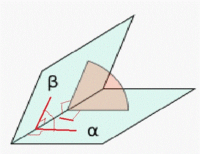You are using an out of date browser. It may not display this or other websites correctly.
You should upgrade or use an alternative browser.
You should upgrade or use an alternative browser.
Angle between 2 straight
- Thread starter RONY1
- Start date
Dr.Peterson
Elite Member
- Joined
- Nov 12, 2017
- Messages
- 16,871
I don't think you mean "an angle with 2 vertices"; that makes no sense! You surely mean the two rays that make up the angle!
Such angles are not all the same, unless you specify that the rays have to be perpendicular to the line of intersection. In fact, you could make an angle with one ray in each plane that is as close to zero as you want! In fact, the angle between the planes is the maximum of all such angles.
Can you quote the definition you were given, so I can see how you might be misreading it?
Such angles are not all the same, unless you specify that the rays have to be perpendicular to the line of intersection. In fact, you could make an angle with one ray in each plane that is as close to zero as you want! In fact, the angle between the planes is the maximum of all such angles.
Can you quote the definition you were given, so I can see how you might be misreading it?
pka
Elite Member
- Joined
- Jan 29, 2005
- Messages
- 11,978
Well is really simpler than that. The angle between two planes is the angle between their normals.Angle between 2 planes. We are taught to locate such an angle with 2 vertices that descend towards the intersection of the planes and the vertex of it. But what is the geometric proof that all the angles we create like this are the same ?!
Given \(\Pi_1: P+t\cdot \vec{N_1}~\&~\Pi_2: P+t\cdot \vec{N_2}\), then the angle between the planes is the angle between \(\vec{N_1}~\&~\vec{N_2}\)
Now to answer your question, that angle does not change because the normals are fixed.
pka
Elite Member
- Joined
- Jan 29, 2005
- Messages
- 11,978
No you explained yourself. You just do not know or don't understand the definition.
The angle between two intersecting planes is the angle between there normals. that is the definition
Example :\(\Pi_1: x-2y+5z=10~\&~\Pi_2: 2x+5y-z=15\) are two planes.
The two normals are \(N_1: <1,-2,5>~\&~N_2: <2,5,-1>\).
The angle between them is \(\arccos\left(\dfrac{N_1\cdot N_2}{\|N_1\|\cdot\|N_2\|}\right)\).
By looking at your own diagram that can be seen.
Dr.Peterson
Elite Member
- Joined
- Nov 12, 2017
- Messages
- 16,871
We really need to know what you have learned. For example, pka used vectors; I chose not to, because you give no indication that that is what you are learning. Is it?
And I asked for the definition you were given, to see whether it actually says what you say it does. Your picture here seems to show right angles, which as I said are required if you make this kind of definition; is that part of your definition, or not?
And I asked for the definition you were given, to see whether it actually says what you say it does. Your picture here seems to show right angles, which as I said are required if you make this kind of definition; is that part of your definition, or not?
Dr.Peterson
Elite Member
- Joined
- Nov 12, 2017
- Messages
- 16,871
Since the rays in either angle are parallel to those in the other (being perpendicular to the same line, and in the same plane), the angles are congruent. You could prove this using congruent triangles.
If they formed different angles with the line, rather than merely being located in different places, then this would not be true.
If they formed different angles with the line, rather than merely being located in different places, then this would not be true.
How exactly do you prove with overlapping triangles ?! Model me with reasons, please ..
In particular, imagine that the same 2-plane intersection line also uses 2 similar planes, let's say adjacent, but the angle between them is a bit different ...
In particular, imagine that the same 2-plane intersection line also uses 2 similar planes, let's say adjacent, but the angle between them is a bit different ...
Dr.Peterson
Elite Member
- Joined
- Nov 12, 2017
- Messages
- 16,871
I have no idea what you mean. What triangles are overlapping? What are "similar planes"? What are "adjacent" planes? Aren't you asking about two different angles in the same two planes?
Dr.Peterson
Elite Member
- Joined
- Nov 12, 2017
- Messages
- 16,871
I don't know what you mean by "overlapping triangles". I mentioned parallel lines. Frankly, it seems obvious to me, just in terms of transformations: the one angle is translated to a different location, where it becomes the second angle. If you are looking for a formal proof in some other system than transformational geometry, what axioms or theorems do you accept for solid geometry? Have you made an attempt?
The definition in high school: It is an angular definition of the method of downloading 2 verticals to the same point, on the intersection of the 2 planes, in each of the planes separately, as I have painted several times in our discussion.
This is easy to prove, if it were two angles on the same plane (simple geometry)
This is easy to prove, if it were two angles on the same plane (simple geometry)
Is there a link to a digital book in space geometry (neither trigonometry nor vectors) that includes claims / theorems and proofs?
In my language, there is no such book, nor paper / plain and digital ...
The above space geometry is neglected in my country's methodology
In my language, there is no such book, nor paper / plain and digital ...
The above space geometry is neglected in my country's methodology
But two lines that share a point, define a plane. Just work in that plane. No need to bother with space or any other plane.The definition in high school: It is an angular definition of the method of downloading 2 verticals to the same point, on the intersection of the 2 planes, in each of the planes separately, as I have painted several times in our discussion.
This is easy to prove, if it were two angles on the same plane (simple geometry)
Last edited by a moderator:



